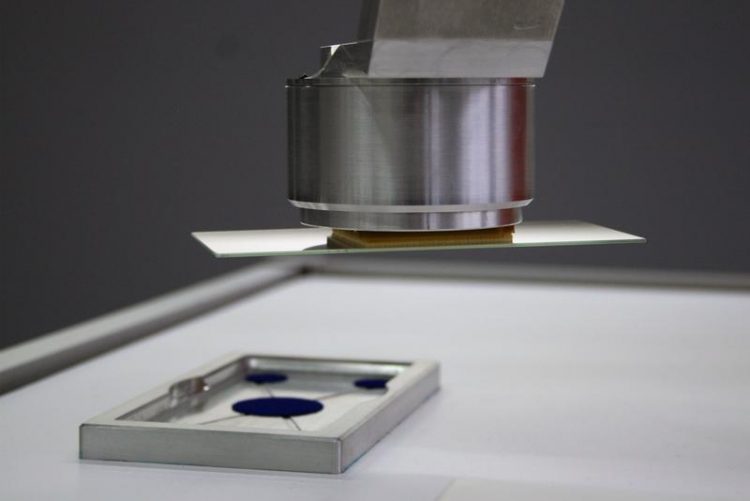Robotic gripping surface for sensitive devices adds a new dimension to Industry 4.0

New robotic gripping surface for sensitive and heavy devices. Copyright: INM
Components with highly sensitive surfaces are used in automotive, semiconductor, display and optical technologies. During production, these parts have to be handled repeatedly by pick-and-place processes.
The proprietary Gecomer® principle reduces the risk of surface contamination with residues, and of mechanical damage due to gripping. In their latest version, researchers at the Leibniz Institute for New Materials (INM) have improved the adhesive force in their Gecomer® structures up to 20 kilogram per 25 square centimeter.
This conforms to the weight of 40 tablets handled with a surface half postcard size. Within these new findings, it will be possible to use the same gripper for heavy and lightweight, sensitive devices. These innovations will open up new avenues for Industry 4.0.
The researchers will be presenting their results from 25 to 29 April 2016 in Hall 2 at the stand B46 of the Hannover Messe in the context of the leading trade fair for R & D and Technology Transfer.
“Artificially produced microscopic pillars, so-called gecko structures, adhere to various items. By manipulating these pillars, the adhesion can be switched on and off. Thus, items can be lifted and released quickly and precisely,” Karsten Moh from INM explains.
“Our new materials add a new dimension to the handling of heavy devices which are sensitive, even in vacuum,” says Moh.
“With the currently developed adhesion system, adhesive forces of more than eight Newton per square centimeter can be achieved. In our tests, the system has proved successful even after 15,000 cycles,” the technology expert Moh says. Even slightly rough surfaces can be handled reliably.
The development group now focuses on the gripping of objects with non-planar surfaces. Additionally, new triggers for switching the adhesion are being explored.
Your contact at the Booth:
Joachim Blau
Mareike Frensmeier
Your expert at INM:
Prof. Eduard Arzt
INM – Leibniz Institute for New Materials
Head Functional Microstructures
Phone: +49681-9300-500
eduard.arzt@leibniz-inm.de
INM conducts research and development to create new materials – for today, tomorrow and beyond. Chemists, physicists, biologists, materials scientists and engineers team up to focus on these essential questions: Which material properties are new, how can they be investigated and how can they be tailored for industrial applications in the future? Four research thrusts determine the current developments at INM: New materials for energy application, new concepts for medical surfaces, new surface materials for tribological systems and nano safety and nano bio. Research at INM is performed in three fields: Nanocomposite Technology, Interface Materials, and Bio Interfaces.
INM – Leibniz Institute for New Materials, situated in Saarbrücken, is an internationally leading centre for materials research. It is an institute of the Leibniz Association and has about 220 employees.
http://www.leibniz-inm.de/en
http://www.leibniz-gemeinschaft.de/en
Media Contact
All latest news from the category: Trade Fair News
Newest articles

Machine learning algorithm reveals long-theorized glass phase in crystal
Scientists have found evidence of an elusive, glassy phase of matter that emerges when a crystal’s perfect internal pattern is disrupted. X-ray technology and machine learning converge to shed light…

Mapping plant functional diversity from space
HKU ecologists revolutionize ecosystem monitoring with novel field-satellite integration. An international team of researchers, led by Professor Jin WU from the School of Biological Sciences at The University of Hong…

Inverters with constant full load capability
…enable an increase in the performance of electric drives. Overheating components significantly limit the performance of drivetrains in electric vehicles. Inverters in particular are subject to a high thermal load,…





















